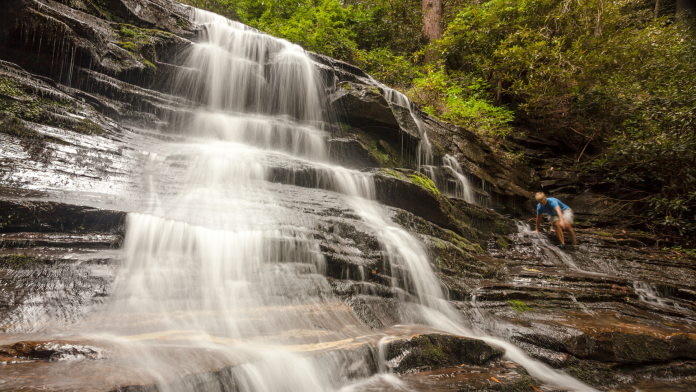We were in Ocho Rios, Jamaica and signed up for the 1,000 ft. waterfall climb (Dunn’s River Falls), set in the beautiful and natural Jamaican countryside.
The falls were huge with fast-moving water over large boulders. But the naturally-terraced waterfall terrain created pools of water that made the climb relatively easy. Well, mostly easy. There were a few scraped ankles and bruised toes, but we all made it up in good shape!
The Jamaican guide instructed us to hold hands and form this long line of people connected like a rope – the rope being made of our hands and arms. It was counterintuitive at first, but it was only when we let go and picked our own rocks to climb, did a few of us slip, fall or scrape a knee.
5 valuable leadership lessons:
1) Someone who has traveled only a few steps farther than you knows something valuable that you don’t yet know.
It’s difficult to put a price tag on experience, even if it’s only a few seconds beyond what you have accomplished. Every step mattered in our climb up the falls. A little to the left and you slip, a little to the right and you step in a deep hole. The leader went first and each person followed — one step at a time.
As a leader, you don’t have to know all the answers, you just need to know the next step and take it successfully. If you do, others can safely follow. Trust is a big deal. People are counting on you to make the right choices.
If you are following, don’t expect your leader to know the entire plan – just the next step. The only reason our Jamaican guide knew every step so well is because he had completed this trip hundreds of times. The more experience your leader has, the better. It helps them navigate new territory.
2) It’s not the steepness of the climb it’s the speed of the water.
There were only a couple of sections that were steep and long enough to make us a little nervous. The surprising thing was that those sections weren’t really that big a deal. The real issue was the speed of the water. It seems like the water would run faster down the steeper sections, but the way it bounced off the boulders made it play unexpected tricks on you. I quickly learned that you can see the boulders, but you can’t see the current.
Isn’t that the way it is in leadership? It’s what you can’t see that can trip you up, cause you to lose footing and stumble. It might be a turn in a relationship, a flip in the economy or change in current culture. You didn’t see it coming and boom. This is why it’s so important to pay attention, ask questions, seek wise counsel and take time to reflect.
What you can’t see is what causes you to lose footing. Pay attention, seek wise counsel.
3) When you want to let go and climb on your own, it’s often a mistake.
Each time I started to slip, my first instinct was to let go of the person’s hand in front of me and try to grab onto the next rock to stabilize myself. Each time I did that, I lost my footing. There was a reason the guide lead us the way he did. Many leaders are entrepreneurs. They are visionaries and cut their own path. That’s good but within limits. All good leaders must be willing to take a hand and be a good follower at some point.
It’s great when a leader steps out to find his or her own path, but there is something about the body of Christ and being a Christ-follower that puts boundaries on a leader’s climb. It’s interesting to note that it’s rarely at the lower levels of the climb that leaders get in trouble. It’s often after some success that leaders begin to call their own shots and then fall. Keep holding on, first to God, and then to others who have traveled before you.
All good leaders must be willing to take a hand and be a good follower at some point. Click & Tweet!
4) The person behind you is depending on you.
This one seems obvious, but when the water is cold and you’ve slipped a couple of times, it’s easy to focus on getting yourself to the top — forgetting about the person behind you.
This happened a few times to our crew. One person said: “The person behind me was too slow, if I held on to them, I’d either stop the whole group or get pulled back down.” In the moment that seemed true, but from the big picture it couldn’t be farther from the truth. It was in the letting go that everyone had to stop and wait.
Each person was counting on the person in front of them to hold on and not let go. The guy in front of me let go only once, and I immediately lost confidence in him for the remainder of the trip. It wasn’t a big deal, this was a fun waterfall climb, but it made me think about situations that were serious and much was at stake. I want to count on the person in front of me.
So let me ask. Can the person behind you count on you to hold on?
5) What looks difficult at the bottom will often seem much easier at the top.
When we all got to the top of the falls, the climb seemed much easier than when we looked up from the bottom. In fact, from the bottom, you couldn’t see much of what was to come. After getting to the top it seemed relatively easy.
Leadership depends on us raising up other leaders. Click & Tweet!
To be a good leader of leaders, a good leadership mentor, you must be willing to go back to the starting point and help others make the climb, even if it’s “easy” for you.
One of the things that made the Jamaican guides so good was that they gave each group 100% of their enthusiasm. For them, it was up the waterfall one more time. For us, it was a once in a lifetime family memory. It’s like the 1,000th time you read John 3:16, but you just shared it with an unchurched person who heard it for the first time! It’s life-changing for them!
That’s what leaders do, add passion to the journey. We inspire even when we’ve been there and done that. And that’s good news because we’re all counting on someone to do the same for us!
Leaders add passion to the journey and inspire even if we’ve been there 1,000 times. Click & Tweet!







